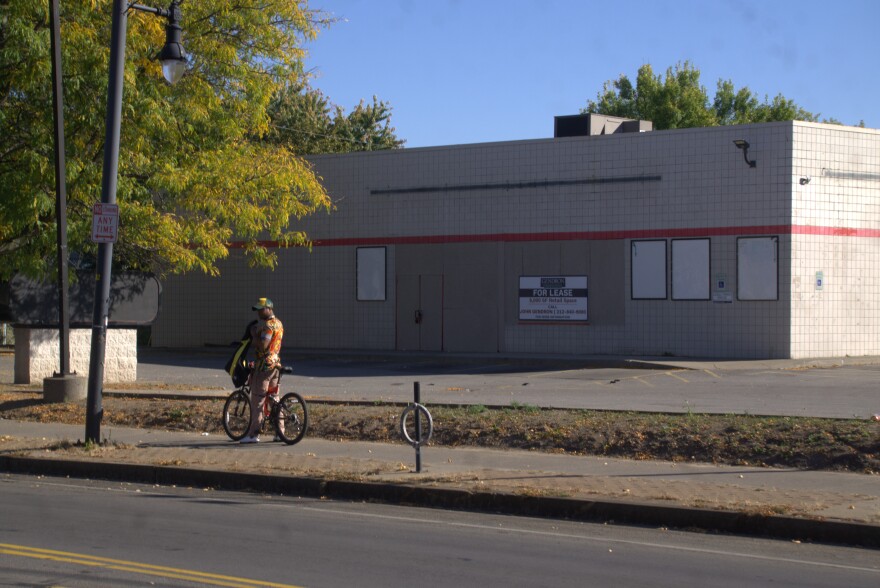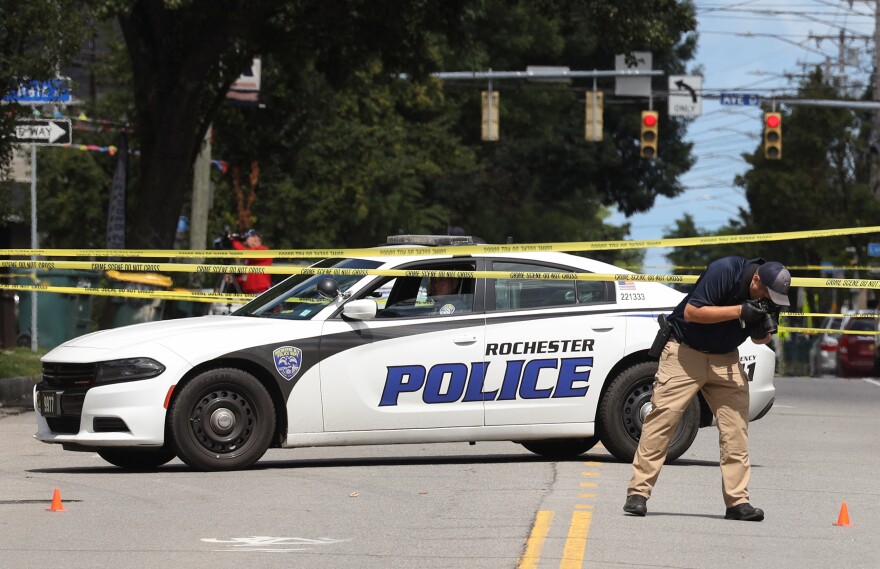Historically, violent crime spikes in the summertime. But this year in Rochester, the period between Memorial Day and Labor Day was the least deadly in years.
This summer’s 11 homicides were the lowest for that time of year since before the COVID-19 pandemic, when violent crime surged nationwide. The statistic is also at its second lowest point in the past decade: in the summer of 2017 there were seven homicides.
Shootings also continue to drop. This summer, 57 people were shot in the city, compared to 65 last year. In the summer of 2021, when violent crime levels peaked, 142 people were shot.
The reasons for the decline are nuanced and complex, ranging from more proactive policing to more cooperative approaches from community groups. In short, it takes a collective effort.
“When you really think about this and be intentional about solving this problem from the multiple prong approach, no one person can take credit for this,” said Willie Lightfoot, founder of the ROC Against Gun Violence Coalition and a member of Rochester City Council. “The coalition can’t take credit, the police department, no mayors, whoever it is.”
Foot patrols and community actions
On the morning of June 22, David Vazquez was shot to death behind a suspected drug house on Oscar Street, just off North Clinton Avenue. Vazquez’s alleged killer, Edison Estremera-Cohen, was spotted later that day by Rochester police, who gave chase.
Police alleged that during the chase, Estremera-Cohen pulled out a handgun and fired at officers. None were hit, but officers returned fire, shooting him three times. He survived, and was charged with second-degree murder, robbery, and aggravated attempted murder of a police officer.
After the incident, Rochester police began a more aggressive approach to the neighborhood, which has long been a center of drug activity and gun violence—18 people have been shot within two blocks of the strip so far this year, and three killed. Police cleared homeless encampments and raided several drug houses. Police also began doing foot patrols in the neighborhood, a rarity in previous years.
“The goal is not arrest with these patrols,” said Captain Greg Bello. “The goal is going out making community contacts. Someone's not going to rob somebody on the corner if there's an officer out there walking. And by meeting the neighborhood and having those, those face-to-face interactions, but also having an officer there proactively, statistically, and studies have shown, reduces violence significantly.”

Those foot patrols typically last around 15 minutes, he said. That timing is based on the 1995 Koper Curve, developed by George Mason University Professor Christopher Koper. That theory suggests that consistent and short patrols in high crime “hot spot” areas has a residual effect in deterring violent crime. Longer patrols have diminishing returns.
Bello also said the department is treating shootings differently than in the past, which has helped with enforcement of violent crime. Previously, if a victim was uncooperative with police following a shooting incident, the investigation effectively ended. Now, police assign detectives to treat each shooting as a full investigation, regardless of whether the victim is cooperating.
“It was very easy to say, ‘Okay, the victim's non-cooperative, we just move on,’” Bello said. "We're not doing that anymore. Even if we can't bring assault type charges because the victim doesn't want to cooperate, that doesn't mean we're not going to hold somebody accountable for firing a weapon in our city.”
Underlying symptoms
It’s a warm October morning and Beatriz LeBron-Harris, director of the Father Tracy Advocacy Center on North Clinton Avenue, walks down the thoroughfare. Virtually everyone she passes seems to know her, whether it’s a formerly homeless man who she helped get placed into a house on the strip or neighborhood members engaged in heated arguments on a street corner.
The North Clinton corridor she sees is rife with issues. The blight is obvious. Many stores are shuttered, including a Rite-Aid that recently closed, and is now a frequent spot for the homeless and drug deals, LeBron-Harris said. Drug use is rampant, and needles litter the many vacant lots that dot the neighborhood. Tents pop up sporadically in shady corners of lots.

The violence in the neighborhood is not a mystery to her. It’s rarely random. More commonly, it’s petty disputes and arguments that spiral into gunshots, she said.
“Understanding what's a random occurrence versus what is interpersonally connected, because it's the interpersonal, connected issues of violence that continue,” LeBron-Harris said. “You have to understand; it’s beef upon beef.”
Outreach to drug users is LeBron-Harris’s specialty, and there’s no shortage of need on North Clinton. But she believes none of these issues exist in a vacuum. Homeless people would set up encampments near the drug houses, which kept them readily supplied. The drug sales, thefts, and arguments would lead to fights and disputes. Those, in turn, would lead to shootings.
“We will mediate as much as we can over here,” she said. “Because, in the past, when they all hang out, and then they start using, and then they start arguing over petty things. Those things have led to physical assaults, which then lead to the gun violence, when someone's getting beat up and all that stuff. You nip it in the bud, do some mediation.”

For LeBron-Harris and other workers at the advocacy center, policing alone does little to solve the issues at hand. Hector Rosario works as a community health worker for the center. He said police raiding drug houses does little to address the core issues in the neighborhood.
“If police raid this area here, you ain't doing nothing, because they’re just going to go down the street,” Rosario said. “If you hit that spot, they’re just going to move. You ain't solving the problem.”
Both Rosario and LeBron-Harris agreed that the long-term solution to the violence in the neighborhood is to meet core needs of the community such as food, shelter, and treatment for addiction, alongside the policing and outreach efforts.
“I think all of those things are factors at play, all of it, and even where I'm at, I'm literally right smack dab in the middle, my door opens into the open drug market,” LeBron-Harris said. “Even that, we've been able to ship and have some dynamics over here, because we're providing services.”
Across the city on Jefferson Avenue, Lightfoot sits inside his barbershop, New Creations.
Lightfoot first started the coalition in 2018. At the time, the city was seeing a decline in gun violence.
Lightfoot saw a need for the city to change how it approaches gun violence. The city government historically did not offer much in the way of human services and social work. Those obligations largely fell on the county.
“I saw a gap where we needed to get into this more,” Lightfoot, a former Monroe County legislator, said.
City Hall began to adopt some of the recommendation put forward by the ROC Against Gun Violence Coalition.
Officials formed the Homicide Response Team to serve as a crisis counseling service provided at the scene to family and loved ones of victims.
Later, the city formed the Person in Crisis Team to serve as a mental health response team.
Councilmember Mary Lupien spearheaded the effort as a response to the death of Daniel Prude while he was in police custody.
The city also renamed the Department of Recreation and Youth Services to the Department of Recreation and Human Services.
Those actions happened in 2018 and 2019, when violent crime was at a low. Lightfoot said those efforts the framework for driving the city’s violent crime rate back down to pre-pandemic levels.
“The blip in the system was the pandemic,” Lightfoot said. “So, quite naturally, whenever you have a blip in the system over time, you'll see it normalize back to what it normally is.”
The city of Rochester is still under a Gun Violence State of Emergency, first enacted by Mayor Malik Evans as one of his first acts in his first term in office. A similar action was taken by Mayor Lovely Warren the previous year.
Lightfoot said he supports the ongoing state of emergency but would also support ending it in the near future given current trends.
But that doesn’t mean the problems are solved.
In his corner of the city, he sees divestment. He said the violence that the city has seen built a “stigma” around people wanting to invest in the community or even visit. He also sees his neighbors as being disengaged from the political system, citing the historically low turnout in this year’s city primary elections. The apathy and divestment, he said, only leads to more blight and violence.
Even as the number of deaths go down, he sees the city as far away from rebuilding a sense of community and growth.
“I'm going to tell you why we're far away from it, because it's not prohibiting people from getting reelected,” he said.



